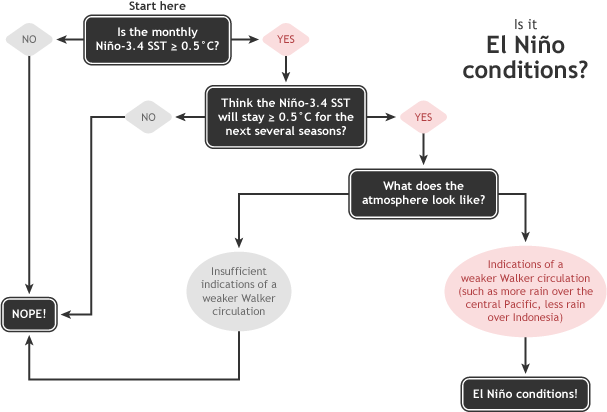
What is El Niño
El Niño is a natural occurrence that happens periodically, characterized by a spike in sea surface temperatures in the central and eastern Pacific Ocean. El Niño is a paired event with La Niña, where ocean temperatures drop below average. However, both mini-style occurrences have a considerable impact on Earth’s weather patterns. The National Oceanic and Atmospheric Administration (NOAA) stated that indicators of El Niño have been already visible and beginning to occur on June 8, 2023. If this pattern persists until October, it will be classified as an El Niño occurrence.
According to NOAA, the wind normally travels westward along the equator in the Pacific Ocean, transporting warm water from the South American region to Asia. This heated water is subsequently replaced by cold, nutrient-rich water rising from the depths of the ocean (upwelling). This warm surface water pushes the thermocline deeper, which is the amount of ocean depth that separates warm surface water from cooler water below.
El Niño Impact
According to the description above, micro-occurrences have a significant impact on weather patterns because the rising ocean temperature forces the Pacific jet Stream to shift south from its regular position. As a result, North America will enjoy warmer temperatures, while the United States’ Gulf Coast and Southeast will experience above-average rainfall, resulting in increased flooding.
El Niño has an impact on both the terrestrial and marine populations. The transfer of nutrients, such as nitrates and phosphates, from these depths promotes the growth of seaweed. These nutrients are also used by phytoplankton as energy for photosynthesis, an important source of energy for bigger fish populations. Based on the foregoing, coastal upwelling zones are among the most productive ecosystems in the world, supporting fisheries, particularly those with ponds near the coast.
El Niño causes the movement of cold and warm water that rotates (upwelling) as the wind blows across the water surface. However, there are times when a thick, warm water layer inhibits usual upwelling. Phytoplankton populations are weakened and reduced by the upwelling of nutrient-rich cold water. Feeding becomes scarce for fish that rely on it, disrupting feeding chains further up the food chain, including seabirds and marine mammals.
In Indonesia, the Chief of Meteorological, Climatological, and Geophysical Agency (BMKG), Dwikorta Karnawati, stated that the peak of El Niño will occur in August and September 2023. This occurrence will have an impact on water supply and food security. Furthermore, even though the region is experiencing drought owing to El Niño, hydrometeorological disasters such as floods and landslides might occur. This is based on Indonesia’s geographical location, which is surrounded by two oceans, as well as its rugged terrain.
As greenhouse gasses continue to rise, the frequency of El Niño events may increase from around once every 20 years to once in every 10 years by the end of the 21st century. El Niño then warms the atmosphere across the central and eastern tropical Pacific, resulting in a greater Hadley circulation and modifications to the jet stream. The Hadley circulation is linked to the jet stream across mid to high latitudes, which sends storms around the world and divides cold and warm air masses.

What to Note About This Phenomenon
ENSO, or El Niño Southern Oscillation, is a cycle that occurs in the tropical Pacific Ocean every few years. It is one of the most extreme year-to-year swings in the Earth’s climate system, influencing agriculture, public health, freshwater supply, power generation, and global economic activity.
As the climate warms, excessive rainfall is expected to travel eastward along the Pacific Ocean equator during El Niño occurrences and in the opposite direction during El Niña events. Other effects of ENSO include extensive coral bleaching and increased Pacific tropical cyclone activity.
In light of the El Niño phenomenon, we must not only prepare water for our daily needs during the drought, but we must also prepare our physical condition to reduce susceptibility to diseases. Proper rest, and consuming foods high in vitamins and protein (eggs, fruits, and vegetables), are several things that can be done to keep the body in good physical condition. Furthermore, always inspect the area around your home for stagnant water, dampness, or poor lighting. These conditions create ideal breeding grounds for mosquitos, which spread dengue fever and malaria. The increase of dengue fever and malaria comes from 2 effects of El Niño: unusual rainfall also increases breeding grounds for disease transmission media, such as mosquitoes, accompanied by an increase in temperature also directly increases the transmission of rapidly transmitted diseases.
This rise in temperature causes water sources to dry up. Heat waves will occur when the temperature rises, costing numerous lives. It can lead humans to overproduce sweat in order to maintain body temperature, causing the body’s organs to work very hard, resulting in fever owing to high temperatures and dehydration due to excessive oil production.
In relation to heat waves and El Niño, food safety is also a topic of concern during this phenomenon. Not only does the body need enough water, it also needs nutrients to maintain body temperature. Due to the effects of El Niño, it affects the crop failures that commonly occur in South and Southeast Asia. The rice harvest in these areas will be considerably less than usual, the rice trade will be much more difficult, and eventually, the price of rice will rise. Maintaining groceries in a place that is not exposed to direct sunlight, not humid, or in the refrigerator (eggs, and some other ingredients to maintain freshness) is a simple way to keep nutrients that will be consumed to maintain body temperature.
The culmination of several problems caused by the mini-style phenomenon is the economic impact. Like health that must be taken care of, diseases that arise due to drought, and food needs, everything depends on money. In order to maintain our health and avoid infectious diseases, we will spend money on immune supplements and vitamins, items to avoid mosquito bites, and more than usual shopping in preparation for the rush.
The Panama Canal, a hub of global trade, was disrupted by low rainfall, causing operators to restrict traffic and resulting in a $200 million drop in revenue. In addition, losses in agricultural products, and the need for medicines in hospitals are also indirectly affected by this natural phenomenon due to changing ocean currents.
After learning about El Niño, and its devastating effects, it is hoped that humans will help each other and realize the importance of protecting the environment so as not to experience water scarcity, food scarcity, and medicine. It’s also up to everyone to ensure that the effects of El Niño are well managed, that pollution and climate change causes that exacerbate El Niño are minimized, and that we can adapt to it without fear of a phenomenon that will continue to occur in the future.

About the Author
Gema Aisyiyah Masruri is a volunteer writer for AYO Post. Her hobbies include reading, cooking, writing, crocheting, and gaming. She also loves to enjoy the rain while drinking tea, reading books, and listening to classical music.